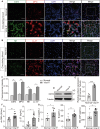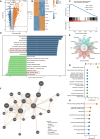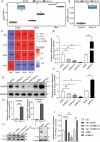Hippo pathway and NLRP3-driven NETosis in macrophages: Mechanisms of viral pneumoniaaggravation
- PMID: 40659620
- PMCID: PMC12260020
- DOI: 10.1038/s41420-025-02556-z
Hippo pathway and NLRP3-driven NETosis in macrophages: Mechanisms of viral pneumoniaaggravation
Abstract
Severe viral infections can precipitate acute lung injury, resulting in significant morbidity and mortality. While NETosis serves as an important defense mechanism against pathogens and viruses, its excessive or dysregulated activation may contribute to pulmonary damage. In this study, elevated levels of NETosis were detected in the peripheral blood of patients with viral pneumonia. To further investigate the relationship between NETosis and virus-induced acute lung injury, a murine model was established using intratracheal administration of poly(I:C), a synthetic analog of double-stranded RNA that mimics viral infection. NETosis biomarkers were assessed in both patients and poly(I:C)-stimulated mice. In addition, we examined the role of the Hippo signaling pathway and its downstream mediators, including inflammatory factors and chemokines. Enhanced NETosis and activation of the Hippo pathway were observed in the lungs of poly(I:C)-treated mice, along with elevated levels of IL-1β in isolated macrophages. These effects were mitigated by Hippo pathway inhibitors. Co-culture experiments confirmed that IL-1β promotes NETosis, while NLRP3, acting downstream of the Hippo pathway, was responsible for IL-1β secretion. Patients with viral pneumonia showed increased NLRP3 and IL-1β expression in monocyte-derived macrophages compared to healthy controls. Overall, our findings indicate that activation of the Hippo pathway in macrophages during poly(I:C) exposure upregulates NLRP3 and IL-1β expression, thereby promoting NETosis and exacerbating virus-induced lung injury. This study highlights a potential therapeutic target to reduce lung damage caused by viral infections.
© 2025. The Author(s).
Conflict of interest statement
Competing interests: The authors declare that the research was conducted in the absence of any commercial or financial relationships that could be construed as a potential conflict of interest.
Figures









Similar articles
-
Hypothermia protects against ventilator-induced lung injury by limiting IL-1β release and NETs formation.Elife. 2025 Jun 24;14:RP101990. doi: 10.7554/eLife.101990. Elife. 2025. PMID: 40553503 Free PMC article.
-
TLR3-mediated NET formation and macrophage activation in acute liver failure: Targeting IL-36 signaling to attenuate inflammatory drivers.Int Immunopharmacol. 2025 Aug 28;161:115112. doi: 10.1016/j.intimp.2025.115112. Epub 2025 Jun 18. Int Immunopharmacol. 2025. PMID: 40554259
-
Xuebijing Injection Alleviates Sepsis-Induced Acute Lung Injury by Inhibition of Cell Apoptosis and Inflammation Through the Hippo Pathway.J Inflamm Res. 2025 Jun 12;18:7717-7733. doi: 10.2147/JIR.S523991. eCollection 2025. J Inflamm Res. 2025. PMID: 40529898 Free PMC article.
-
Inhaled magnesium sulfate in the treatment of acute asthma.Cochrane Database Syst Rev. 2017 Nov 28;11(11):CD003898. doi: 10.1002/14651858.CD003898.pub6. Cochrane Database Syst Rev. 2017. PMID: 29182799 Free PMC article.
-
Measures implemented in the school setting to contain the COVID-19 pandemic.Cochrane Database Syst Rev. 2022 Jan 17;1(1):CD015029. doi: 10.1002/14651858.CD015029. Cochrane Database Syst Rev. 2022. Update in: Cochrane Database Syst Rev. 2024 May 2;5:CD015029. doi: 10.1002/14651858.CD015029.pub2. PMID: 35037252 Free PMC article. Updated.
References
-
- Gu S, Pan P, Wang J, Shi Y, Shi F, Zhang Y, et al. Exploring influenza a virus-induced lung injury and immune response based on humanized lung-on-chip. Discov Med. 2023;35:539–52. - PubMed
LinkOut - more resources
Full Text Sources

